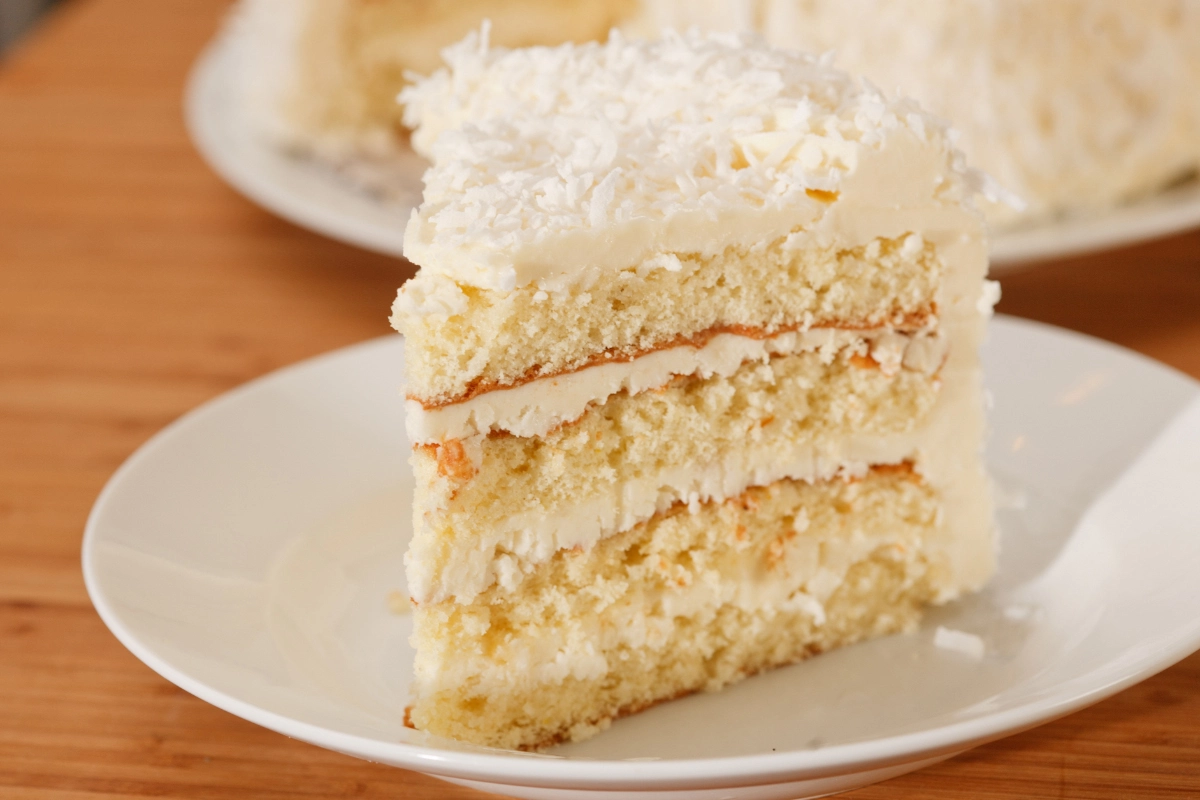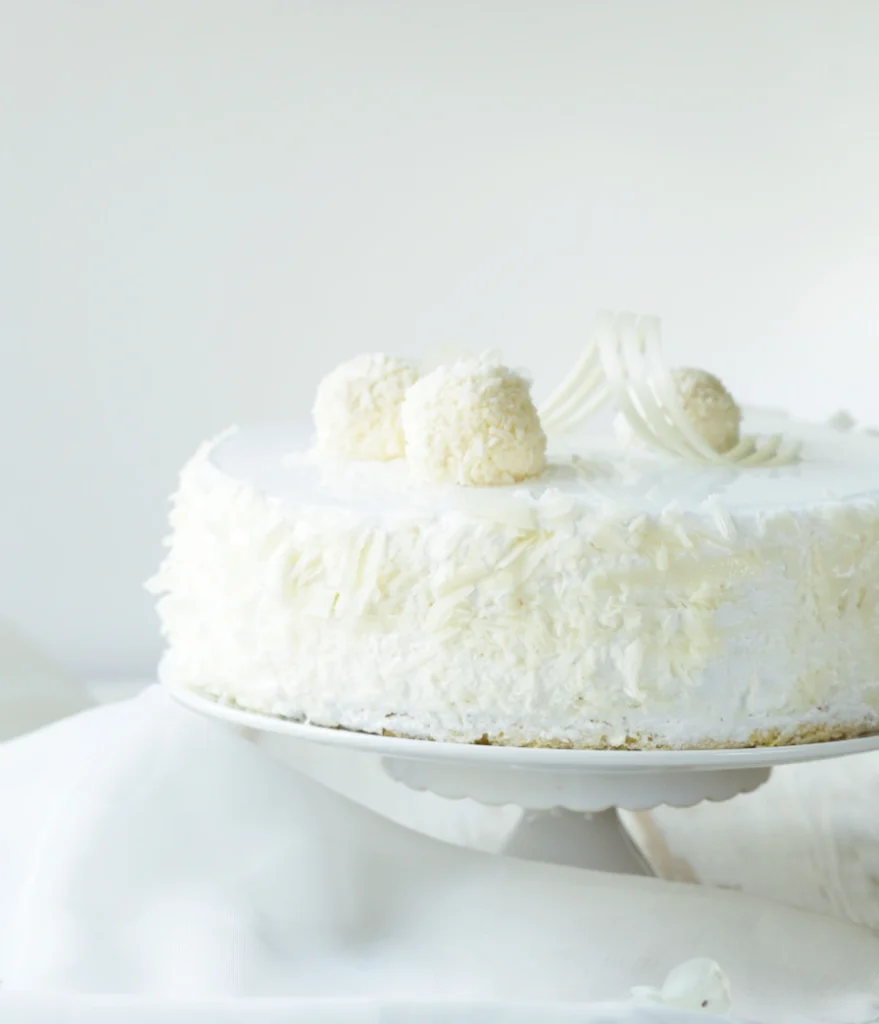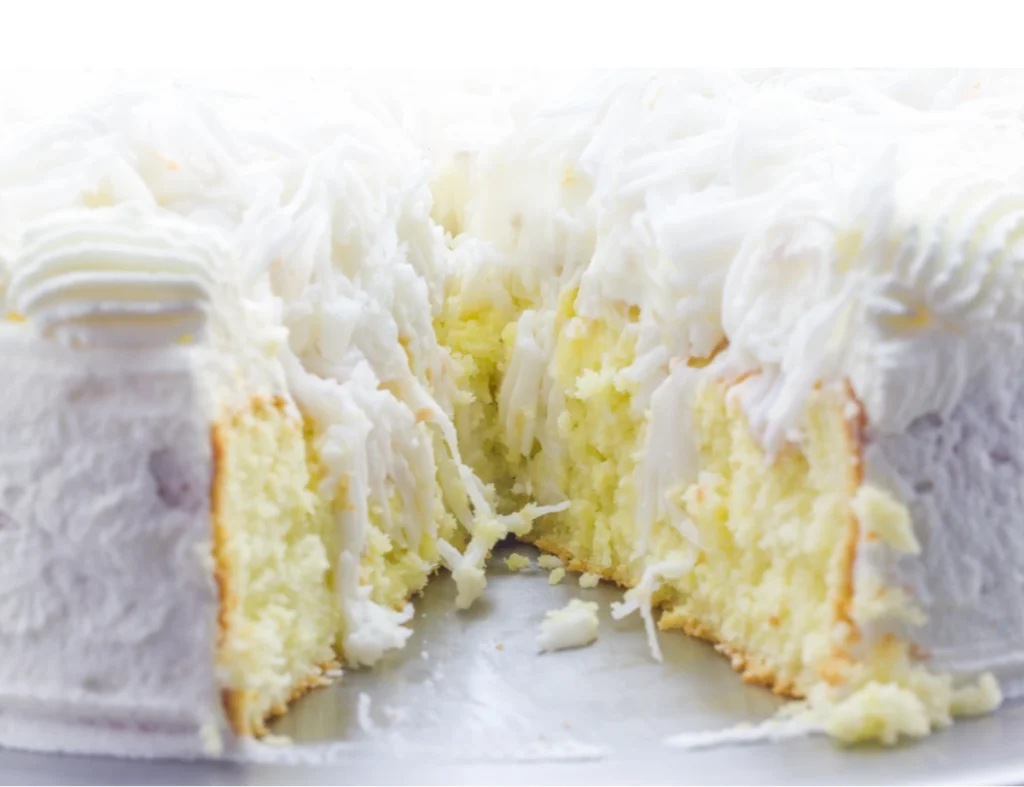Coconut cake – the mere mention conjures images of fluffy layers, snowy frosting, and the irresistible taste of the tropics. This beloved dessert has captured hearts (and taste buds) for generations, and good reason. Its delicate sweetness, moist texture, and delightful coconut flavor make it a true crowd-pleaser. Whether you’re a seasoned baker or a novice in the kitchen, this comprehensive guide will equip you with everything you need to create a coconut cake masterpiece. From choosing the right recipe to frosting and decorating tips, we’ll explore the secrets to baking a coconut cake that’s not just delicious but also uniquely yours. So, let’s embark on this sweet journey together and unlock the magic of coconut cake!
Coconut Cake Recipe: A Comprehensive Guide
Introduction
The coconut cake – is a dessert that needs a little introduction. Its popularity spans cultures and continents, gracing tables at birthdays, weddings, and countless special occasions. But what exactly is it about this cake that makes it so universally adored? Perhaps it’s the way the moist crumb melts in your mouth or the delicate balance of sweetness and coconut flavor that transports you to a tropical paradise. Whatever the reason, one thing is certain: coconut cake holds a special place in the hearts (and stomachs) of dessert enthusiasts everywhere.
In this comprehensive guide, we’ll delve into the world of coconut cake, exploring its many variations and providing you with all the knowledge you need to bake your slice of heaven. From classic recipes to creative twists, and frosting options to decorating techniques, we’ve got you covered. So, preheat your ovens and get ready to embark on a delightful coconut cake adventure!
Choosing the Right Coconut Cake Recipe
With so many coconut cake recipes out there, it can be overwhelming to choose the perfect one. But fret not! We’ll break down some popular options to help you find your ideal match.
- Classic Coconut Cake: Ah, the timeless classic. This recipe is a must-try for any coconut cake enthusiast. It typically features a moist vanilla cake base generously studded with shredded coconut and layered with a luscious coconut cream cheese frosting. The result? A symphony of textures and flavors that’s simply irresistible.
- Variations: Feeling adventurous? The world of coconut cake extends far beyond the classic. Explore the tangy twist of a pineapple coconut cake, the refreshing zest of a lemon coconut cake, or the decadent indulgence of a chocolate coconut cake. Each variation offers a unique flavor profile while retaining the essence of coconut that we all love.
- Dietary Options: Dietary restrictions shouldn’t stop you from enjoying a slice of coconut cake heaven. Whether you’re following a gluten-free, dairy-free, or vegan lifestyle, there are plenty of recipes tailored to your needs. We’ll touch upon these options later in the article, so stay tuned!
Essential Ingredients
Now that you’ve chosen your desired coconut cake style, let’s gather the essential ingredients that will transform your vision into a delectable reality. Remember, using high-quality ingredients is key to achieving the best flavor and texture.
Essential Ingredients
- Flour: The foundation of any cake, flour provides structure and texture. For coconut cake, all-purpose flour is a popular choice, offering a good balance of tenderness and strength. If you’re aiming for an extra-light and airy crumb, consider using cake flour. And for those with gluten sensitivities, gluten-free flour blends can be used with fantastic results.
- Sugar: The sweetener that brings joy to our taste buds! Granulated sugar is the most common choice for coconut cake, providing sweetness and moisture. Brown sugar can add a hint of caramel-like depth, while coconut sugar complements the overall flavor profile with its subtle butterscotch notes.
- Coconut: The star of the show! Using quality coconut products is crucial for an authentic and flavorful coconut cake. Opt for unsweetened shredded coconut for the cake batter and frosting. Coconut milk adds richness and moisture, while coconut extract intensifies the tropical flavor.
- Other Key Ingredients: A supporting cast of ingredients plays a vital role in creating a successful coconut cake. Eggs provide structure and richness, butter adds flavor and tenderness, and leavening agents like baking powder and baking soda give the cake its rise. Flavorings such as vanilla extract or almond extract can complement the coconut beautifully.
Think of these ingredients as your artistic palette, each one contributing to the masterpiece that is your coconut cake. By understanding their roles and choosing them with care, you’re setting the stage for baking success.
Step-by-Step Coconut Cake Recipe
It’s time to put those ingredients to work and create some coconut cake magic! This step-by-step guide will walk you through the process of making a classic coconut cake batter, baking it to perfection, and preparing it for its frosting glory.
Step-by-Step Coconut Cake Recipe
-
Preparing the Cake Batter:
-
- Preheat the oven and prep your pans: Start by preheating your oven to the temperature specified in your chosen recipe. Grease and flour your cake pans to ensure easy removal later.
- Whisk the dry ingredients: In a large bowl, whisk together the flour, baking powder, baking soda, and salt. This ensures that the leavening agents are evenly distributed, resulting in a cake that rises beautifully.
- Cream the butter and sugar: In a separate bowl, cream together the softened butter and sugar until light and fluffy. This step incorporates air into the batter, creating a tender crumb.
- Add eggs one at a time: Beat in the eggs one at a time, mixing well after each addition. This helps to emulsify the batter and create a smooth texture.
- Alternate wet and dry ingredients: Gradually add the dry ingredients to the wet ingredients, alternating with the coconut milk. Begin and end with the dry ingredients, mixing until just combined. Avoid over-mixing, as this can lead to a dense cake.
- Fold in the coconut: Gently fold in the shredded coconut until evenly distributed throughout the batter.
-
Baking the Cake:
-
- Divide the batter: Pour the batter evenly into the prepared cake pans.
- Bake to perfection: Bake for the time specified in your recipe, or until a toothpick inserted into the center comes out clean or with a few moist crumbs attached.
- Cool the cakes: Once baked, let the cakes cool in the pans for about 10 minutes before inverting them onto a wire rack to cool completely. This prevents the cakes from breaking apart.
-
Cooling and Layering:
-
- Ensure complete cooling: Make sure the cakes are completely cool before frosting. This prevents the frosting from melting and becoming runny.
- Level the cakes (optional): If your cake layers have domed tops, you can use a serrated knife to level them for even stacking.
- Prepare for frosting: Once the cakes are cool and level, you’re ready to move on to the exciting part – frosting and decorating!
As you follow these steps, remember that baking is a science, but it’s also an art. Don’t be afraid to experiment and add your personal touch to the process. After all, the best coconut cake is the one that you enjoy making and sharing with loved ones.
Frosting and Decorating Your Coconut Cake
The cake layers are baked and cooled, and now it’s time for the grand finale – frosting and decorating! This is where you can truly let your creativity shine, transforming your coconut cake into a stunning centerpiece.
Coconut Frosting Options
The right frosting can elevate a coconut cake from delicious to divine. Let’s explore some popular options that perfectly complement the tropical flavors of the cake:
- Classic Coconut Cream Cheese Frosting: This is a classic pairing for a reason. The tangy cream cheese balances the sweetness of the cake and frosting, while the coconut flavor shines through. It’s creamy, dreamy, and utterly addictive.
- Coconut Buttercream Frosting: For those who prefer a sweeter and smoother frosting, coconut buttercream is an excellent choice. It’s light and fluffy, with a rich coconut flavor that melts in your mouth.
- Whipped Coconut Cream Frosting: If you’re looking for a lighter option, whipped coconut cream is the answer. Its airy texture and subtle coconut notes make it a refreshing choice, especially during warmer months.
- Other Frosting Variations: Feel free to explore beyond the realm of coconut. Chocolate ganache adds a decadent touch, cream cheese frosting offers a classic pairing, and fruit-based frostings like mango or passionfruit can create a tropical explosion of flavors.
The choice is yours! Consider the overall flavor profile you desire and the occasion for which you’re baking.
Decorating Techniques
Once you’ve chosen your frosting, it’s time to unleash your inner artist and decorate your coconut cake. Here are a few ideas to get you started:
- Simple Frosting: For an elegant and effortless look, simply frost the cake with smooth sides and a decorative swirl on top. This allows the flavors of the cake and frosting to take center stage.
- Coconut Flakes: Embrace the coconut theme by generously sprinkling coconut flakes on the sides and top of the cake. You can create a beautiful textured effect or even form decorative patterns.
- Fresh Fruit: Add a pop of color and freshness with fresh fruit. Berries, pineapple, mango, and kiwi are all excellent choices that complement the tropical flavors of the cake.
- Other Decorative Elements: Edible flowers, chocolate shavings, piped designs, and even small decorative items like seashells or miniature umbrellas can add a touch of whimsy and personality to your coconut cake.
Remember, there are no hard and fast rules when it comes to decorating. Have fun, experiment, and let your creativity flow! The most important thing is to create a coconut cake that you’re proud to present and that will delight your taste buds and those of your lucky guests.
Tips for the Perfect Coconut Cake
Baking a coconut cake doesn’t have to be a daunting task. With a few handy tips and tricks, you can ensure that your cake turns out moist, flavorful, and irresistible. Let’s delve into some expert advice to help you achieve coconut cake perfection:
Tips for the Perfect Coconut Cake
- Measuring Ingredients Accurately: Baking is a science, and precision is key. Ensure that you measure all your ingredients accurately, especially the flour. Too much flour can result in a dry and dense cake, while too little can make it crumbly. Use measuring cups and spoons specifically designed for dry and wet ingredients, and level off the tops for precise measurements.
- Using Room Temperature Ingredients: This tip is often overlooked, but it makes a world of difference. Using room-temperature ingredients, particularly butter and eggs, allows them to blend more easily and evenly, creating a smooth and well-incorporated batter. This, in turn, leads to a more tender and consistent crumb. So, take your ingredients out of the refrigerator about an hour before you start baking.
- Mixing Techniques: While it’s important to mix the ingredients thoroughly, over-mixing can develop the gluten in the flour, resulting in a tough and chewy cake. Mix the batter until the ingredients are just combined – a few lumps are perfectly fine. Remember, a gentle hand is key to a tender crumb.
- Testing for Doneness: Knowing when your cake is perfectly baked is crucial. The toothpick test is a reliable method. Simply insert a toothpick into the center of the cake. If it comes out clean or with a few moist crumbs attached, your cake is done. If it comes out with wet batter, it needs more time in the oven.
- Cooling the Cakes Properly: Patience is a virtue when it comes to cooling cakes. Allowing the cakes to cool completely in the pans and then on a wire rack prevents them from breaking apart or becoming soggy when frosted.
By following these simple tips, you’ll be well on your way to baking a coconut cake that will impress everyone who takes a bite. Remember, practice makes perfect, so don’t be discouraged if your first attempt isn’t flawless. Keep baking, keep experimenting, and most importantly, keep enjoying the sweet journey of creating delicious coconut cakes!
Frequently Asked Questions (FAQs) About Coconut Cake
As you embark on your coconut cake-baking adventures, questions may arise. Worry not! We’ve compiled a list of frequently asked questions to provide you with the answers and guidance you need:
What is the Tom Cruise coconut cake?
The Tom Cruise coconut cake is a famous white chocolate coconut bundt cake from Doan’s Bakery in Woodland Hills, California. Tom Cruise reportedly loves this cake and often sends it as a gift to his friends and colleagues during the holidays. It’s known for its moist texture, rich flavor, and decadent cream cheese frosting.
Is Dolly Parton’s coconut cake mix good?
Dolly Parton partnered with Duncan Hines to create a line of Southern-inspired cake mixes, including a coconut cake mix. Reviews for the mix are generally positive, with many people praising its ease of use and delicious results. It’s a convenient option for those who want to enjoy a tasty coconut cake without starting from scratch.
Does coconut oil change the taste of cake?
Coconut oil can subtly alter the taste of a cake. It adds a hint of coconut flavor, which can complement the overall taste, especially in recipes that already call for coconut. However, if you’re looking for a completely neutral-tasting oil, coconut oil might not be the best choice.
Can I use a different type of milk in the recipe?
Absolutely! While coconut milk enhances the tropical flavor, you can substitute it with other types of milk, such as almond milk, soy milk, or even cow’s milk. Keep in mind that the flavor and texture of the cake may vary slightly depending on the milk you choose. For example, almond milk might impart a subtle nutty flavor, while cow’s milk will result in a richer cake.
How do I store coconut cake?
To keep your coconut cake fresh and moist, store it in an airtight container at room temperature for up to 3 days. If you live in a warm or humid climate, it’s best to refrigerate the cake to prevent spoilage. Before serving, allow the cake to come to room temperature for about 30 minutes to enhance its flavors and texture.
Can I freeze coconut cake?
Yes, you can freeze coconut cake, both frosted and unfrosted. If unfrosted, wrap the cake layers tightly in plastic wrap and then aluminum foil before freezing. For frosted cakes, freeze the cake uncovered for about an hour to firm up the frosting, then wrap it tightly as described above. Frozen coconut cake can be stored for up to 2 months. When ready to enjoy, thaw the cake overnight in the refrigerator and bring it to room temperature before serving.
With these FAQs answered you’re well-equipped to tackle any coconut cake challenge that comes your way. Remember, baking is a journey of exploration and discovery. Embrace the process, have fun, and enjoy the sweet rewards of your coconut cake creations!
We’ve reached the end of our coconut cake adventure!
From understanding the essential ingredients and choosing the perfect recipe to frosting, decorating, and troubleshooting, we’ve covered everything you need to know to bake a coconut cake that will impress and delight you.
Remember, baking is a journey, not a destination. So, embrace the process, have fun, and let your creativity shine. With each cake you bake, you’ll gain confidence, refine your skills, and discover the joy of creating something truly special.
Now, go forth and bake your coconut cake masterpiece! The world awaits your sweet creations.
More Delicious Recipes:
- Papusa: Dive into the heartwarming flavors of El Salvador with our homemade Papusa recipe! These stuffed delights are not only a staple in Central American cuisine but also a treat for anyone who loves to explore rich, savory flavors.
- Vermicelli: Embark on a culinary adventure with our light and flavorful Vermicelli recipes! Perfect for those who enjoy quick, healthy meals, Vermicelli is versatile and pairs beautifully with a variety of ingredients. Whether tossed in a tangy sauce or stirred into a vibrant salad, each recipe is designed to refresh and satisfy.
Vermicelli: A Comprehensive Guide to Types, Uses, and Recipes



